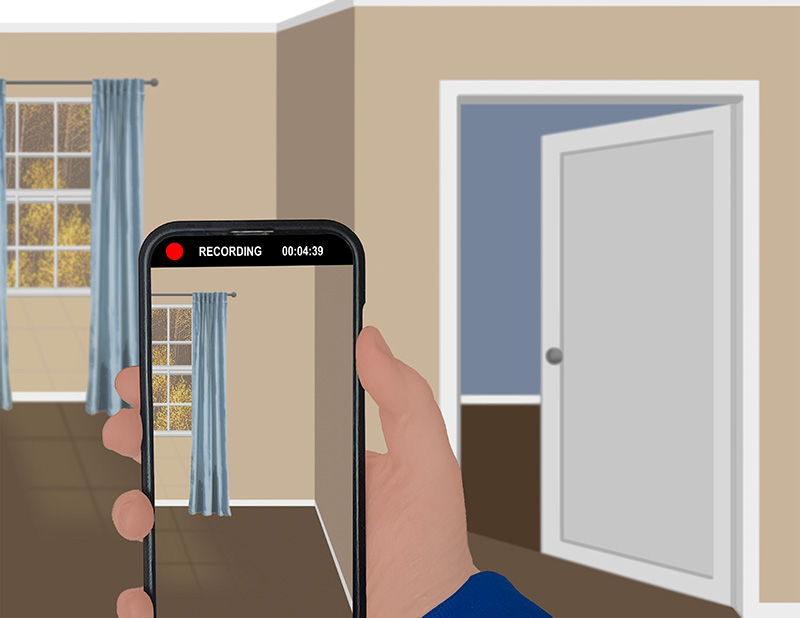How Technology Can Help with Virtual Showings and Renting Apartments
By Kimberly Rau, MassLandlords, Inc.
Virtual rental tours started as a necessity for real estate agent Sherri Way during the pandemic. Travel restrictions were in place, but people were still moving. They were moving for new jobs after pandemic-related closures, or relocating after their current job went remote. But everyone was skittish about letting strangers into their homes. She needed to find a way to connect people with housing, but not endanger the people currently living there. Three years later, this technological workaround has become standard practice.

Video tours are a great way to let people visualize your rental unit while minimizing foot traffic in the apartment. (Image license: CC by SA 4.0 MassLandlords, Inc.)
“We kind of turned the process around,” said Way, who operates in the MetroWest area of the state. She noted that before the pandemic, the general procedure for getting an apartment rented was to show the property, then take applications and screen potential tenants. But with lockdown restrictions ever-tightening in 2020, Way knew that wouldn’t work anymore.
“We didn’t want to do showings unless people were really qualified or really interested,” she added. Way started asking tenants who were currently living in the soon-to-be-available units to take videos of the home, along with measurements of each room. Those virtual assets were then sent to potential tenants, who could visualize the space. If they liked what they saw, Way would send them the rental application and perform her standard full-tenant screening. If they passed, she would then conduct an in-person showing if they wanted one.
“Since the pandemic’s over, we kept the video and the application part in place,” Way said. She only shows rentals to qualified prospective tenants. This cuts down on foot traffic in the unit, which the current residents appreciate. It also saves time for the landlord or rental agent, as the tire kickers and no-shows are largely weeded out during the application and screening processes.
Want to embrace technology in your own rental showing? Read on to learn about three best practices for virtually showing rental units and narrowing the field before anyone steps foot in the apartment.
Best Practice #1: Videos and Measurements Help Potential Renters Decide
If the unit you want to rent out is empty, then go in yourself and take pictures and a short video tour of the rental. A walk-through video will help renters understand the layout of the place much better than a collection of still photos. Think of all the housing ads you’ve seen in which, even after 30 photographs, you’re still not sure where the third bedroom is in relation to the rest of the place. Make sure you include any features you want to highlight, such as the walk-out to the backyard, or in-unit laundry hookups.
Then, get out your measuring tape and get dimensions of all the rooms. You may already have these from when you bought the property; just make sure they take into account any renovations you might have done. Providing these measurements is important. Renters bring furniture with them; they need to know if the rooms will be big enough to meet their needs. Can the living room accommodate their three-piece sectional? Is that second bedroom big enough for two twin beds? Will the main bedroom fit their California king mattress?
If the unit you are looking to rent out is currently occupied, ask your tenant if they would be willing to take the video and measurements for you. Remind them that doing so will likely cut down on the number of in-person tours that you will need to do. If they are not able to help you, work out a time with them when you can come in and do it yourself.
Best Practice #2: Applications Catch What a Pre-screening May Miss, and Vice Versa
Now that you have your video and measurements, it’s time to advertise the apartment. If you can’t upload the video to the listing site of your choice, you can state it is available and send it to interested tenants.
Way was clear that she both pre-screens her potential renters and has them fill out a rental application (this is ours, made available free to members). Seeing the application ahead of time gives Way a good idea of whether the tenant is likely to be approved. And, the application catches things that the pre-screening may not.
She also makes sure to verify income, and asks if the tenant has pets, or is a smoker. She checks for prior evictions. If people balk at filling out the application before taking an in-person tour of the place, that doesn’t bother Way.
“If you’re not interested in filling out the application, then you’re obviously not interested in the place and you’re a tire kicker anyway,” she stated. This wastes her time, and if the unit is still occupied, the current residents’ time as well.
“Your goal is to get qualified tenants who you want to rent to,” said Way. “And the best way to do that is to get as much information about them up front as you can.”
Best Practice #3: Set Up Showings Only for Tenants Who Pass the Initial Screening
If the potential renter fills out the application and passes the pre-screening, then it’s time to do an in-person showing. In Way’s experience, since only truly interested tenants reach this stage, the number of no-shows for tours has dropped.
Way said that now that pandemic restrictions are a thing of the past, she strongly urges even out-of-state applicants to see the home in person. At the very least, she asks them to send a trusted representative to come out and take a tour, so they can vet the place with their own eyes before signing a rental agreement. If this is impossible, Way can do a Zoom meeting and live walkthrough of the place.
After the pandemic, some people are still uncertain about strangers walking through the home they are living in. Way advises her clients to wear masks. This adds another layer of comfort for everyone.
Conclusion
Virtual tours and Zoom walk-throughs may not be for everyone. There are plenty of renters who either cannot or do not want to embrace technology at the level that makes such things possible. But technology isn’t going away, and trying to get a vacancy filled can be a time-consuming process. Utilizing certain tools can save you a lot of time and energy, and it’s easier than you think to get started. If you have a smartphone with a data plan, you have all the tools you need to incorporate video tours and Zoom meetings into your leasing practices. Why not give it a try?




